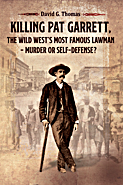|
|
 |
|
|
|
|
 |
|
Dedicated to those who
served in VT-4, VB-4, VF-4,
VMF-124 and VMF-213
|
|
|
 |
 |
|
Operation Leader - The German View
|
 |
 |
|
Introduction
Gerald W. Thomas, VT-4
On October 4, 1943, aircraft from the USS Ranger attacked German shipping along the coast of Norway under the code name "OPERATION LEADER." Several reports of these strikes from the viewpoint of the Allies are available. On this web site, see "Norway: A Grateful Nation Remembers," "USS Ranger Veterans Return to Norway," and "Operation Leader: Initiation Over Norway" in Torpedo Squadron Four: A Cockpit View of World War II.
Now we have access to the German version of this operation, thanks to Steinbjørn Mentzoni, who obtained this record from the Norwegian archives of captured wartime German records.
This report, originally in German, was made by a high-level officer of Nazi forces along the Norwegian Coast. We are fortunate to have the translation from German to English by Maurice E. Swinnen.
An analysis of the report follows the translation.
|
 |
|
|
|
Translation Notes
Maurice E. Swinnen
A few remarks about this translation.
Many military abbreviations are used. I still remember some of them from my World War II days. I have used the English translations of those abbreviations. Here are my justifications for them:
- D is used for "Dampfer" = steamship or steamboat.
- T is used for "Tanker," identical in both languages.
- M stands for "Marine" = Navy.
- MFS stands for "Marinefunkstation" = Navy Wireless Station.
- H stands for "Heer" or mostly in the genitive form "Heeres" = Army or of the Army.
- HKA stands for "Heeres KustenArtillerie" = Army Coastal Artillery.
- HKB stands for "Heeres KustenBatterie" = Army Coastal Battery.
- FLUWA is military slang for "Flugzeug Abwehr" = airplane defense. It almost always refers to a radar station. There are 3 mentions of FLUWA here: "FLUWA Vega," "FLUWA Branningen," and "FLUWA Indre Kvaröy." Vega and Branningen are towns, Indre Kvaröy an island north of Sandnessjöen.
- TAB stands for "Tankeranlagebetonunterstand" = oil bunker. (Tanker = oil tanker, anlage = installation, and betonunterstand = concrete bunker).
- There are several mentions of "Jäger Regiment." The word "Jäger" translates as hunter.
- "Ölinsel" = oil island.
- NS refers to ships of the Norwegian occupation government.
- Some abbreviations like MFP, KR, and others don't ring a bell. So, I simply left them untouched.
I surprisingly recognize the typewriter this was typed on, an Adler, German Army issue. It had the peculiarity to type a smaller zero (less high) than normal, this to distinguish between a zero and an Oh. The Germans never thought about the solution introduced on American teletype and now also widely accepted on computer printers: putting a slash through the zero.
After the war, in 1946, I bought one of those babies in Belgium at a US Army surplus store. The sergeant in charge said, "you want a doorstop, buddy," when I showed interest in the machine. He let me have the "useless" thing for the equivalent of $1. It was a product of superb German precision engineering. I used it for 4 years to type all of my college assignments on it at the University of Louvain, where the State Department had sent me to study languages. The typewriter traveled with me overseas for 10 years, where I sold it just before coming back home to the US.
The keyboard was not QWERTY, as in the US, but typical European AZERTY, so it took me some time to get used to. But it had all the special accents ^, `, ' etc. on keys that had no automatic advance. So, you typed the accent first and then hit the letter key. The result was ö, è, ñ, and â without interruption of your typing speed. Handy.
I would like to draw your attention to the description of the utter chaos that haunted the Navy guy who wrote these pages. He says, that when enemy airplanes attacked, the first ones to hit the airwaves with messages were the Army. The Army and the Navy shared one channel. So when the Army clogged up that channel, the Navy was in no position to warn its outlying posts and ships. He is pleading, obviously for the umpteenth time, to have a special channel for Navy use only.
Then he complains about coding errors in the voice transmissions, which even further clogs up the channel, because of needless requests for corrections and re-transmissions.
When he is not complaining about the wireless connections, he says that the telephone and teletype wire connections are constantly noisy and with interruptions. He uses the word "gestört," which can mean "disturbed," "noisy," "interfered with, "or even "jammed."
A curious spelling has me worried about this fellow. He insists on spelling the name of the city of Trondheim as "Drontheim." But my German friends here in our Edelweiss dance group tell me that both spellings were once acceptable, although not anymore.
Among the many ships names, I see that the Kriegsmarine (German War Navy) must have confiscated ships all over Europe and not even bothered to rename them. There are German and Norwegian names, and even one lone Dutch or Belgian ship, the Kerkplein = Church Plaza.
Translation Notes, Part 2
This "reverse engineering" of these German writings from 60 years ago fascinates me.
I asked myself, "Who is the fellow who was writing all this? Is he an admiral?" Of course not. He receives his orders from the Admiral of the North Coast. But he is an important individual, and he knows it himself. Why? He not only gives the facts to his superiors, but he also offers his opinion as to how the show should be run. It is no ordinary sailor who can permit himself this luxury; he would probably be court marshaled. So, he must be the next lower rank, a Kriegsmarine Kapitän, a Navy Captain. That is a rank equivalent to a Colonel in the Army.
Now, to achieve that rank, he probably is a professional ship's captain with about 30 years of experience at sea, pressed into service by the war, and about 50 years old. He must have been a dedicated professional. He is, however, caught between a rock and a hard place. On the one side, he is frustrated in his fight for resources by the almighty German Army. And on the other hand, he is harassed by the Allied airplanes attacking his precious ships. And his only weapon against those attacks are his anti-aircraft guns. He has no control over the Luftwaffe, the German Air Force.
His convoys supply other Navy vessels and the Army stationed along the long and jagged coast of Norway. And what they need is ammunition (the Allies sunk one of his ships loaded with 40 tons of the stuff) and oil or gasoline. He talks about his ships accompanying a tanker. He mentions the place of Mo several times. Mo is situated about 30 km northeast of Hemnesberget and about 100 km south of Bodö. Mo lies in the middle of mountain peaks (about 5300 feet high), well protected inside a fjord. So, what is so important about Mo that he mentions it as "bei befehl TAB Mo (by order of TAB Mo)?"
I phoned my Norwegian friend Jacques who is about my age and came to the States when he was 22, after he had served in the Norwegian Army, occupying Germany after the war. When I asked him about Mo, he stated that it still has important oil installations, ever since the Germans built them there during WWII. Bingo!
To safeguard their precious oil installations, the Germans not only situated them in between relatively high mountain peaks, but they also covered them with almost impenetrable concrete roofs. So, here is the German word for such an installation "Tankeranlagebetonunterstand." If you unravel this, you get the word "Tanker" (no explanation needed), the word "Anlage" (installation), and the word "Betonunterstand" (concrete bunker). Hence, TAB at Mo.
The Germans built the same type of installations at the French coast to protect their U-Boats. They called them "Unterseebootbetonunterstand" (under sea boat concrete bunker).
The author also talks at one time about "Ölinsel" without saying where it is situated. Now that word translates as "oil island." Maybe it is also situated at Mo? But we can only guess.
|
|
|
|
 |
|
|
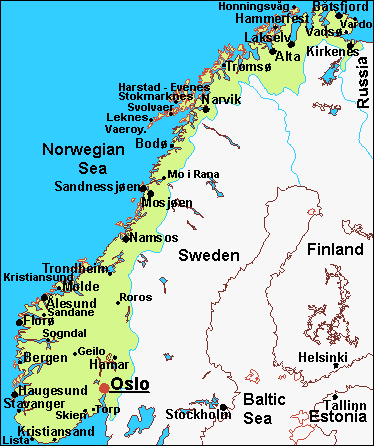 |
 |
 |
|
The German Report
The following disturbances occurred.
Teletype channels:
|
 |
|
|
|
0720 hour
|
Bodö and Trondheim interrupted.
|
|
0913 hours
|
Bodö and Trondheim clear.
|
|
1100 hours
|
Bodö and Trondheim interrupted.
|
|
From 1200 hours
|
Trondheim clear.
|
|
From 1920 hours
|
Trondheim interrupted.
|
|
|
During the night on both channels no traffic.
|
|
 |
 |
|
Telephone channels:
|
 |
|
|
|
Sandnessjöen - Trondheim (Navy channel) from 1300 hours
|
Interrupted
|
|
Sandnessjöen - Trondheim from 1600 hours
|
One channel interrupted
|
|
Sandnessjöen - Bodö from 1600 hours
|
Interrupted
|
|
 |
 |
|
Three lines illegible.
|
 |
|
|
|
1632
|
Anti-aircraft alarm finished.
Intruder squadron recognized as our own.
|
|
1650
|
By command of the Admiral of the North Coast:
Coastal alarm phase I.
|
|
1845
|
By command of the Admiral of the North Coast:
Coastal alarm phase III.
Reason: From Squadron leader Lofoten 1300 06 East. 17 war ships and a carrier sighted. Course 90 degrees. Message delayed for reasons of communications interruptions (starting at Sandnessjöen at 1905 hours).
|
|
2008
|
By command of the Admiral of the North Coast:
Ships traffic stopped.
|
|
2030
|
By command of the Navy Commandant:
Advice by Wireless Communication to fishing fleet to enter nearest harbor ASAP.
|
|
 |
 |
|
After the start of the battles, all communication channels were overloaded.
1. Wireless connections:
Because of the Navy wireless traffic, the frequency "Fritz-Anton" was immediately overloaded. On "Karl-Nanni" there was no connection at all. The decoding of the Navy voice traffic was slowed down considerably because some messages contained coding errors, which had to be signaled to them by new return messages. Unnecessary inquiries and coding work were the results. The faster coding procedure Norway FVH, foreseen for these cases, was not used at all.
The command post at Trondheim at this time did not hear the communications directly, but the Navy Wireless installation at Rörvik worked as a re-transmitter. In some cases, and because of the bad transmission conditions, the command post at Trondheim interrupted the re-routing of wireless traffic of the Navy voice traffic by way of Navy Wireless Station Rörvik. This in order to arrange a traffic agreement with Molde. This in turn caused new delays in the schedules of the anti-aircraft guns.
Due to these disturbances in the normal transmission channels, the coastal channels were even more overloaded, because urgent teletype messages had to be transmitted by means of these channels.
2. Wire connections.
The wire connection between Bodö and Sandnessjöen is inadequate. It is impossible to reach Bodö by wire quickly and, after a connection is made, to have even a clear telephone conversation. A telephone connection Bodö-Sandnessjöen exclusively for Navy use has to be called for again, in view of the often repeated experiences mentioned. The existing connection is being used jointly by the Army and the Navy and it is split at Hemnes and at Mo. When the Army sends messages about enemy activity, it clogs the line immediately and it becomes impossible to have urgent conversations between Bodö and Sandnessjöen.
Existing connections: Teletype line Bodö-Sandnessjöen and Sandnessjöen-Trondheim. Further Telephone connection Sandnessjöen-Trondheim.
In agreement with Chef 9.M.S.Fl., positions Bruno (NSa 01) with Navy 365 and Cäsar (NSa 04) Navy 253 reenforced.
Patrol vessel 5904 takes over the anti-aircraft protection of the steamships "Völsum" and "Malaga" anchored in the fjord of Beiar.
Soldiers brought into Bodö on the "Völsum" have been activated as reenforcements.
By command of the Admiral of the North Coast: Normal readiness.
Ships traffic, also in the region of Sandnessjöen, given free course.
Convoy arrangement: North convoy.
|
 |
|
|
|
1300 from Sandnessjöen
|
Patrol vessels "Kärnten" (5712) and Navy 401 with Steamship "Jupiter" to Lödingen.
|
|
1615 from Rörvik
|
Patrol vessels "Rother Adler" (NSa 02) and "Warthegau" (5704) with Tanker "Saarburg" to the oil transfer of Tanker "Schleswig."
|
|
 |
 |
|
Radio communications.
Teletype connection Sandnessjöen - Bodö still interrupted. Trondheim clear starting 1105 hours.
|
 |
 |
|
Air Defense Brenningen announces:
|
 |
|
|
|
0733
|
24 BDk down.
|
|
About 0740
|
Attack of an enemy squadron on the convoy Trondheim 317 with bombs and on-board weapons. Convoy consisted of tanker "Schleswig" and steamship "Kerkplein" escorted by Navy 365 in the region Schärenweg south of South Arnöy. "Schleswig" hit by three bombs becomes unable to be maneuvered. "Kerkplein" hit by two bombs, rear part of ship burns, rudder falls out.
One airplane shot down.
For assistance from Bodö:
NN 06, 02, NSa 04 came out of harbor.
(First announcement through FT. M 365, received 1020 hours.)
|
|
0740- 0755
|
Anti-aircraft action by battery Arnöy. (see battle announcement)
|
|
 |
 |
|
Air Defense Vega announces:
|
 |
|
|
|
0746
|
16 EDk unknown means 11-1.
|
|
0749
|
Airplane alarm in Sandessjöen.
|
|
0750
|
Enemy squadron consisting of 16 American monoplanes (carrier airplanes) recognized as type "Martlet" fly over Sandnessjöen between Alsten and Dönna, course North North East, distance about 2000 meters, height 600 to 800 meters.
The opponent, who was first on a direct course to Sandnessjöen, after the action started by the anti-aircraft, now flies West and keeps itself on the border out of reach of the 1 anti-aircraft.
Anti-aircraft. Anti-aircraft defense by:
Battery Sandnessjöen
Anti-aircraft platoon Oil Island II/Army Gunnery Battery A.
Regiment 914.
4. Platoon 8./Jäger Regiment 28. L.
NSa 05, 21, 22, Patrol Vessel 5712, Navy 401.
|
|
0755 to 0810
|
Enemy squadron attacks in the sector Army Gunnery Battery B Fagerviken with bombs and on-board weapons the steamship "Vaagen" and steamship "Topeka." "Vaagen" sunk after being hit by bomb. "Topeka" burning after being hit by three bombs and grounded at Langneset (island of Lökta).
Participation at the anti-aircraft action by Army Gunnery Battery B Fagerviken.
Two planes shot down. One American pilot, taken prisoner by Army Gunnery Battery B Fagerviken, will be brought later by NSa 24 to Mosjöen to be delivered to the Luftwaffe (Air Force) for further transport.
Search for remains of two airplanes by patrol of the Jäger Regiment 28 without success. (see battle announcement)
To assist "Topeka" and "Vaagen," the following ships left Sandnessjöen: NSa 11, 12, 21, 26, Navy 401 and Fjord-boat 41.
|
|
0800
|
Airplane alarm in Bodö.
|
|
0802 to 0806
|
Attack by the Northern enemy squadron with bombs and on-board weapons on ships in the harbor at anchor at Bodö.
|
|
 |
 |
|
Air Defense Sandnessjöen announces:
|
 |
|
|
|
|
Happenings
|
|
|
Steamship "Rabat" hit by bomb and sunk.
Steamship "Cap. Quir" damaged by bomb under the waterline. Will be grounded at the harbor.
Steamship "Maläga" lightly damaged by a dud bomb. (After the attack it run to ground when trying to reach Langstranden. Has to be put into dry dock in the harbor.)
Steamship "Ibis" on the road from Bodö to Fauske lightly damaged.
(First message without correct statement at 0822 by MAA 510.)
Participation of anti-aircraft defense by battery Hammerviken and Navy Patrol Vessel Hernes.
One airplane shot down.
|
|
0808
|
Northern enemy squadron flew away in northerly direction toward Bricksvaer.
|
|
0818
|
Attack by three airplanes of the southern squadron near Handnesholm with bombs and on board weapons on MFS 231, which was en route with 40 tons of ammunition. After a third bomb hit on the front of the ship, it was grounded near Handnessholm. Three lightly wounded.
(Message 11.40 - Assistance by NSa 21, 22).
|
|
About 0830
|
Attack by the southern enemy forces with bombs and on board weapons near Rödöy on the convoy Trondheim 218 consisting of Troop Transporter "Skramstad," Steamship "Wölsum," and Steamship "La Plata," all escorted by Navy 36. "Skramstad" was hit by a bomb east of Otervaër and "La Plata" was hit by three bombs. Both were burning and set on the beach near Rödöyviken. "Wölsum" was damaged by onboard weapons shelling.
(First message by FT. M 36 arrived at 0854, assistance by Navy 36 and 5904. Farther from Bodö NN 06, 02 also ND "Ragnvald Jarl" and "Steigen" put in action)
|
|
0855
|
Anti-aircraft alarm finished.
|
|
0903
|
The southern enemy squadron leaves by Küwa Aasvaer to the South West.
|
|
0920
|
Airplane alarm and anti-aircraft alarm Sandnessjöen finished.
|
|
0953
|
By command of the Oil Bunker Mo:
Coastal alarm.
|
|
1010
|
By command of the Admiral of the North Coast:
Coastal alarm phase III.
|
|
1159
|
By command of the Admiral of the North Coast:
Coastal alarm phase II.
|
|
1603
|
Anti-aircraft alarm for Greater Sandnessjöen and Bröhnöysund.
Reason: Air Defense Indre Kvaröy announces at 1535 hours:
One airplane squadron 10-9.
|
|
 |
|
|
|
Analysis of the German Report
Gerald W. Thomas and David Thomas
At dawn on October 4, 1943, Task Force 121 under the overall command of British Admiral Sir Bruce Fraser was positioned about 100 miles off the coast of Norway, near the Arctic Circle. A forced delay in air operations was necessary due to calm air conditions; however, by 0618, with 31 knots over the flight deck of the USS Ranger, OPERATION LEADER was initiated.
The attacking aircraft were divided into two waves. A Northern Attack Group consisting of 20 SBD Dauntless dive-bombers and an escort of 8 F4F Wildcat fighters were directed to attack shipping and shore installations near the port of Bodö. A Southern Attack Group consisting of 10 TBF Avengers and 6 F4F Wildcats was directed toward Sandnessjöen.
|

|
|
SBD Dauntless Dive-Bombers over the Norwegian Fjords
during OPERATION LEADER.
|
|
|
Two Norwegians were assigned to Air Group 4 to assist with the planning and conduct of the attacks. With the Northern Attack Group, Lt Odd Dahm occupied the gunner´s seat on SBD 4-B-7 flown by Lt Henry T. Stratton. Lt Hans G. Kirsebom, RNMAF, flew as an extra crewman with Air Group Commander Joseph A. Ruddy in TBF "C" in the Southern Attack Group. Rear Admiral O. M. Hustvedt stated, "The Norwegian pilots, who had been requested, contributed most valuable assistance both in preparation of the flight crews and in confirming the recognition of land marks during actual attacks."
Both attack groups were ordered to fly at 50-100 feet above the water to avoid detection. After making land fall, the planes climbed to 1500 to 2000 feet to position themselves for masthead or dive-bombing attacks.
The German Report is focused primarily on the strikes by the Southern Attack Group, with reports issued from Air Defense Brenningen, Air Defense Vega, and Air Defense Sandnessjöen.
|
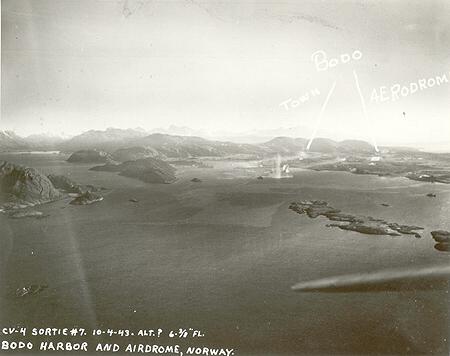
|
|
Bodø Harbor under attack by SBD dive-bombers and F4F fighters of Northern Attack Group.
|
|
|
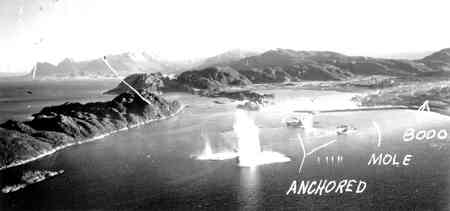
|
|
German ships in Bodø Harbor under attack.
|
|
|
Communication Problems
The German Report indicates serious communication problems between Sandnessjöen, Trondheim, and Bodö and between the Army and Navy throughout the strike period. Also numerous complaints about coding errors, lost time, and channels "constantly noisy with interruptions."
"The Army and Navy shared one channel. When enemy planes attacked, the first ones to hit the airways with messages were the Army. When the Army clogged up the channel, the Navy was in no position to warn outlying posts and ships."
These problems undoubtedly helped the Americans by reducing anti-aircraft losses and delaying fighter interception.
The Ranger Air Group was also concerned about communications. In a pre-flight briefing to pilots of Torpedo 4, Executive Officer Lt. Homer H. Hutcheson stated:
"Complete radio silence (Condition A) is in effect throughout flight, except VHF (Very High Frequency) will be employed for tactical control within the leads only." (Only the Air Group Commander and the Commander of VB-4 had VHF radio.)
Torpedo Four Skipper Lt Cdr David W. Taylor added to the briefing for the Southern Attack Group:
"We will maintain radio silence on our MHF (Medium High Frequency) channel. We must not reveal the location of the Task Force or the nature of our attacks. Visual hand signals with wing wobbling will be used to initiate our attacks."
Later, when Palmer's plane got hit with AA fire, Cdr Taylor broke radio silence, "I called the burning plane by radio, and told all hands to jump." (Letter from Taylor to the Miller family, dated 17 October 1943.)
At one point in the attacks by the Northern Attack Group, Cdr George O. Klinsmann of VB-4 stated in his Aircraft Action Report:
"Due to failure of communications in Group Leader´s plane, there was a delay after this attack, before proceeding to a prearranged rendezvous point where Group Leader received information of divisions with unexpended bombs and ordered attacks on shipping in Bodo Harbor."
Time Sequence
OPERATION LEADER times in the US reports are in GCT, which is an hour later than the Norwegian time used in German Report. In the time sequence that follows, all times have been adjusted to the German usage for easy comparison. Time references from the German Report are in bold.
|
|
|
|
0430
|
Flight Quarters. Pilots and crew laid up to their respective Ready Rooms. (Action Report)
|
|
0600
|
Intended Zero Hour. Delay due to calm wind conditions. (Action Report)
|
|
0618
|
First VB-4 dive-bombers launched. This is the Northern Attack Group (20 SBDs and 8 F4Fs). (Action Report)
|
|
0640
|
Northern Attack Group completes rendezvous and departs carrier. The SBDs were organized in five 4-plane divisions, the fighters in two 4-plane sections. (Action Report)
|
|
0644
|
Sunrise (Action Report)
|
|
0658
|
First VT-4 torpedo-bombers launched. This is the Southern Attack Group (10 TBFs and 6 F4Fs). (Action Report)
|
|
0708
|
Southern Attack Group completes rendezvous and departs carrier. (Cressman)
|
|
0724
|
One division of the Northern Attack Group sights the La Plata, which is strafed by fighters and bombed at mask head by two SBDs. Lt(jg) Prince H. Gordon, pilot of one the SBDs reports, "I went in very close, so close in fact I had to pull up severely to miss foremast." The two remaining SBDs considered the La Plata severely damaged and did not attack, but the La Plata was less damaged than thought. The La Plata was hit again later by the Southern Attack Group. (Action Report) This strike is not recorded by the German Report.
|
|
About
0726
|
The Northern Attack Group sights three Norwegian fishing vessels and a Norwegian passenger vessel, which are not attacked.
|
|
|
|
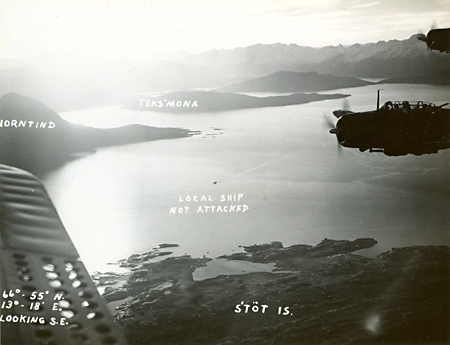
|
|
Fishing Vessel Sighted by Northern Attack Group
|
|
|
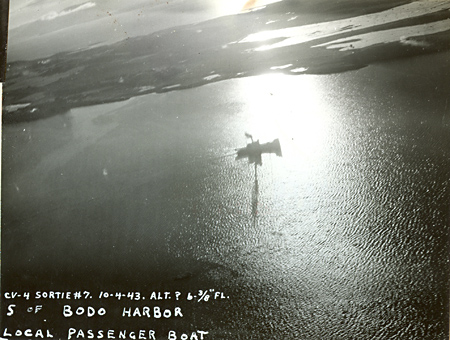
|
|
Passenger Vessel Sighted by Northern Attack Group
|
|
|
|
|
About
0740
|
Air Defense Brenningen reports the attack on Convoy Trondheim 317, consisting of the Schleswig, Kerkplein, and Navy 365. "Schleswig hit by three bombs, becomes unable to to be maneuvered. Kerkplein hit by two bombs, rear part of ship burns, rudder falls out. One aircraft is reported shot down."
This attack is by the Northern Attack Group and recorded in the Action Report as occurring at 0729.
The Action Report identifies the Schleswig as a Rigmor-class oil tanker. Norwegian sources state that the Schleswig was carrying oil for the wounded German battleship Tirpitz. The Schleswig was strafed repeatedly and hit by two bombs, with one near miss.
The Action Report states that the Kerkplein, identified as M/V in the photos, was strafed heavily and hit by one bomb just aft of the stack. "When last seen, ship was proceeding at reduced speed, smoking slightly and turning in to beach." The German Report states that the Kerkplein was hit by two bombs. Unknown to the attackers, the Kerkplein was carrying 1,551 Russian prisoners. Cressman reports the attack seriously wounded 29 and left 9 missing.
The Action Report states that Navy 365, identified in the photos as Flackship, was strafed heavily, resulting in slight damage.
The downed aircraft probably refers to an F4F piloted by Lt(jg) George M. Harris which was hit by AA. Although seriously wounded, Harris successfully returned to the Ranger.
|
|
|
|
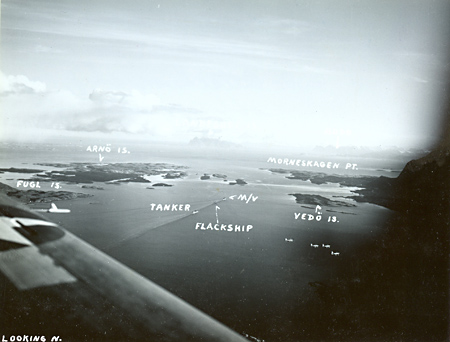
|
|
Convoy Trondheim 317 sighted by Northern Attack Group. Schleswig identified as Tanker, Navy 365 as Flackship, and Kerkplein as M/V.
|
|
|

|
|
Schleswig, identified as "Rigmor," under attack.
|
|
|
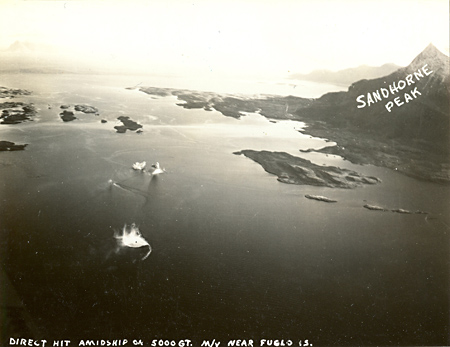
|
|
Kerkplein at moment of bomb hit.
|
|
|
|
|
0749
|
Air Defense Vega reports airplane alarm in Sandnessjöen.
|
|
0750
|
Air Defense Vega reports 16 American monoplanes flying over Sandnessjöen. This is the Southern Attack Group.
|
|
0755-0810
|
Air Defense Vega reports attacks on the Vaagen and Topeka in the sector Army Gunnery Battery B Fagerviken.
This attack is by the Southern Attack Group and is more accurately reported as occuring at 0834 in the Action Report. For an account of this attack, see the 0830 time section.
Vega also reports action by Army Gunnery Battery B Fagerviken, with two planes shot down, one pilot taken prisoner. The downed plane is TBF 4-T-4 piloted by Lt(jg) John H. Palmer, with crewmen Joseph L. Zalom, ART1c and Reginald Miller, AMM1c. Palmer was taken prisoner, Zalom and Miller were lost with the plane. (See Airmen Missing in Action and Prisoners of War from Air Group 4.)
No second plane was shot down. This report probably refers to Lt(jg) Gerald W. Thomas' plane, which was hit, but returned successfully to the carrier. (See Norway: A Grateful Nation Remembers.)
|
|
0800
|
Air Defense Vega reports airplane alarm in Bodö.
|
|
0802-0806
|
Air Defense Vega reports attack with bombs and on-board weapons on ships in the harbor at anchor at Bodö.
This attack is by the Northern Attack Group. Four ships in Bodö harbor are hit: the Malaga, Cap Guir, Rabat, and Lutjehorn. In the Action Report, the Malaga is identified incorrectly as the Saar and the other ships as M/Vs.
The Malaga was strafed heavily and bombed twice, one bomb hitting near the starboard side, the other missing by 50 feet. Although forced to run ashore, the Malaga was not sunk as reported in the Action Report.
The Cap Guir and Rabat were anchored when attacked. The Cap Guir was slightly damaged, the Rabat sunk by a bomb.
The Lutjehorn was in the inner harbor and strafed.
Two SBDs were shot down in this attack. Lt Clyde A. Tucker´s SBD was "hit by explosive shells, apparently one near the base of the right wing and one or more in engine. His plane was on fire and went down in a 30 degree dive from about 200 feet. It exploded as it hit the water." Tucker and his crewman Stephen D. Bakran, ARM2c, were lost with the plane.
Lt(jg) Sumner R. Davis´ SBD, "the last one over the target is believed to have received a hit in the engine, as white smoke was seen coming from underneath as he signaled section leader his engine was losing oil pressure. About 12 miles west of Bodö he made an excellent forced landing at sea; wheels up and flaps open. Two planes circled and saw Davis and his rear seat man, [Donald W.] McCarley, [ARM2c], get the life raft out and board it. Both gave the pilots of the circling planes `thumbs up´ and circling planes departed to join the group."
Davis and McCarley were taken to a Norwegian home, but the Germans located them easily and they became POWs.
The Action Report gives 0800 for this strike.
|
|
|
|

|
|
Malaga under attack in Bodø Harbor by Northern Attack Group. The Malaga was incorrectly identified as "Saar."
|
|
|
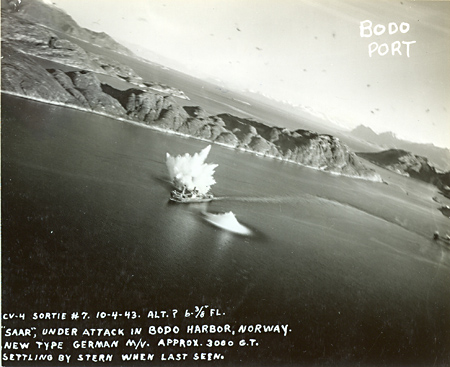
|
|
Another photo of the Malaga under attack.
|
|
|
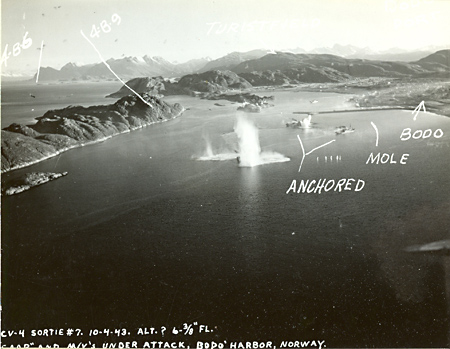
|
|
Photo showing the Malaga, Cap Guir, and Rabat under attack in the Bodø Harbor. The Cap Guir and Rabat were at anchor.
|
|
|

|
|
SBD 4-B-19 piloted by Lt(jg) Clyde A. Tucker with ARM2c Stephen D. Bakran as gunner passes Kunna Head South of Bodø.
|
|
|
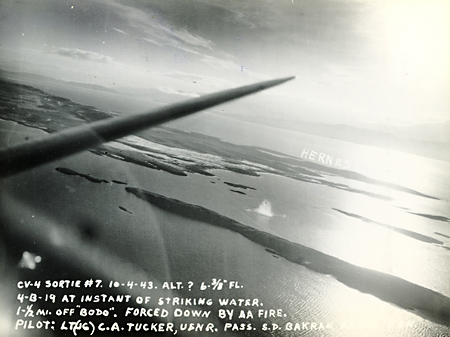
|
|
SBD 4-B-19 strikes the water after being shot down by AA fire.
|
|
|
|
|
0808
|
Air Defense Sandnessjöen reports northern enemy squadron flying away in a northerly direction toward Bricksvaer. This is the Northern Attack Group returning to the Ranger.
|
|
0818
|
Air Defense Sandnessjöen reports attack on MFS 231 by three planes with bombs and on board weapons. Three lightly wounded.
This attack is by the Southern Attack Group. The Action Report states:
"0820 -- A northbound oil tanker, the F231, 800 G. T., travelling alone between Tomma and Handneso was strafed and bombed by 4-T-8 (Trexler) and 4-T-9 (Thomas) and 4-T-3 (Hamrick). Seven bombs were dropped and there were several near misses. The tanker then ran aground in the Bay of Valla, after which one bomb from 4-T-9 (Thomas) hit amidships. There was one AA gun forward and one aft, and the crews were seen to leave their guns during the strafing, and abandon ship. The engine of 4-T-9 (Thomas) was hit, and a bad oil leak developed."
See also Operation Leader: Initiation Over Norway in Torpedo Squadron Four: A Cockpit View of World War II.
|
|
|
|
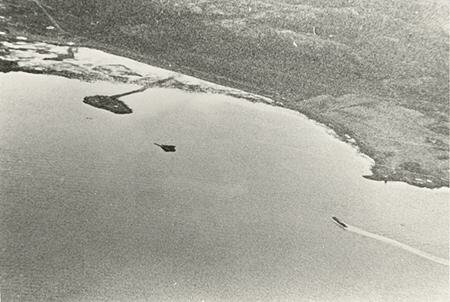
|
|
MFS 231 sighted by Southern Attack Group.
|
|
|
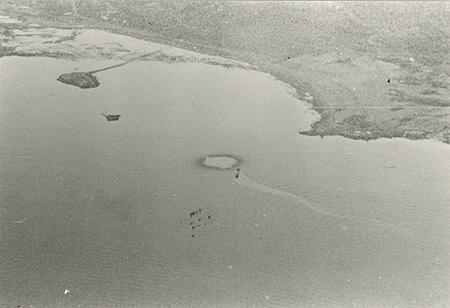
|
|
First of 7 bombs dropped on MFS 231.
|
|
|
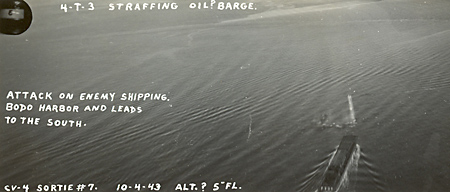
|
|
MFS 231 being strafed by TBF 4-T-3, piloted by Lt(jg) Lawrence L. Hamrick.
|
|
|

|
|
Close up of MFS 231 strafing by TBF 4-T-3.
|
|
|
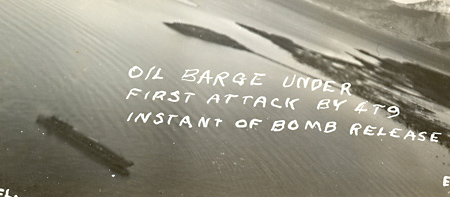
|
|
Wing-mounted camera photo of MFS 231 an instant before first bomb attack by TBF 4-T-9, piloted by Lt(jg) Gerald W. Thomas. This bomb missed the ship.
|
|
|

|
|
MFS 231 just prior to second bomb attack by TBF 4-T-9. This bomb hit amidship.
|
|
|
|
|
0830
|
Air Defense Sandnessjöen reports attack by the southern enemy forces with bombs and on board weapons on the convoy Trondheim 218, consisting of the Skramstad, Wolsum, and La Plata.
This attack is by the Southern Attack Group. The Action Report states:
"0834 -- Three cargo ships and two escort vessels, one a torpedo boat, were sighted just off the southern tip of Bodö, the largest apparently dead in the water. Photographs indicated that this ship had been previously attacked by the Northern Group."
"0836 -- The largest ship, La Plata, 8056 G. T. was strafed by all VF (twice by 4-F-25 and 4-F-11) and bombed by CGAG-4 (Ruddy) and 4-T-3 (Hamrick). She received two direct hits forward and there were two near misses. A large red explosion occurred and the ship was left burning."
The La Plata was transporting supplies and cargo for the German army.
"The other two cargo ships were painted gray. One of the large ships had its funnel marked with a red band and with a white 'k' on it. (Klavenes Line, Lysaker). It was strafed by 4-F-13, 4-F-10, 4-F-20, and 4-F-22: and bombed by CCAG-4 who scored a direct hit on the stern, and a near miss. When last seen it was smoking slightly."
The ship with the "K" on the funnel was the Skramstad. Unknown to the attackers, the Skramstad was carrying 834 German cavalrymen and infantrymen. The attack on the Skramstad killed 200 of the German soldiers and seriously wounded 15. One Norwegian crewman was killed, Øivind Larsen. See We Survived and An Amateur Astronomer in the German Army for accounts by survivors of this attack.
The third cargo ship was the Topeka, not mentioned by Air Defense Sandnessjöen, but identified by Air Defense Vega as being attacked at 0810. The Topeka was carrying building materials for Germany. The Topeka was hit by three bombs, killing three Norwegians and 8 German soldiers.
Identified only as an "escort vessel," the Vaagan was sunk by a bomb. Unknown to the attackers, the Vaagan was not in the service of Germany -- it was carrying oatmeal and butter. No one was seriously hurt in the attack on the Vaagan.
"The torpedo boat was strafed by 4-F-20 and 4-F-22."
The torpedo boat is apparantly the ship identified as the Wolsum in the German Report.
"There was AA fire from the large cargo ships and particularly heavy AA fire from the torpedo and flak ships. It is reported to have been 20 mm, inaccurate but close."
|
|
|
|
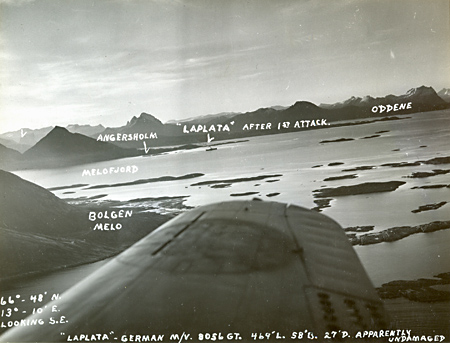
|
|
La Plata sighted by the Southern Attack Group. The ship had been attacked previously by the Northern Attack Group.
|
|
|

|
|
La Plata under attack by the Southern Attack Group.
|
|
|

|
|
La Plata being stafed by an F4F piloted by Lt(jg) William W. Taylor as a second F4F comes in at mask level.
|
|
|

|
|
Topeka just prior to attack by TBF 4-T-1, piloted by Cdr David W. Taylor.
|
|
|
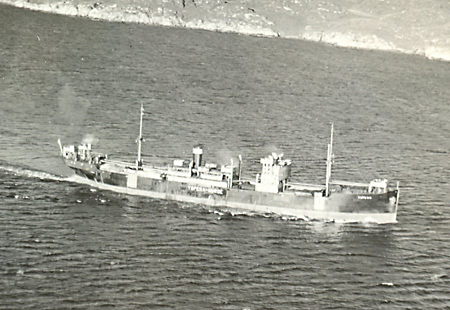
|
|
|
|

|
|
Topeka after bombing. Photo courtesy of Steinbjørn Mentzoni.
|
|
|

|
|
Vaagan just prior to attack by TBF 4-T-6, piloted by Lt Homer H. Hutcheson.
|
|
|
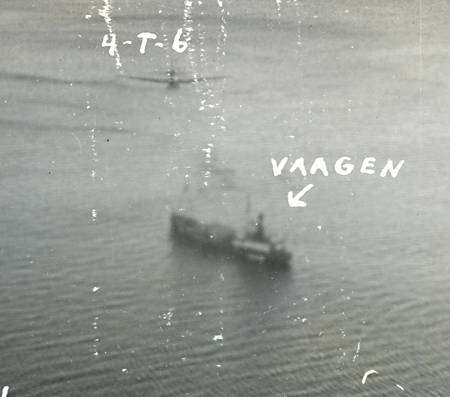
|
|
Vaagan with TBF 4-T-6 coming in for bomb drop.
|
|
|

|
|
Vaagan being rocked by two bombs, one on each side.
|
|
|

|
|
Another shot of the Vaagan.
|
|
|
|
|
0834-0903
|
Air Defense Sandnessjöen reports the southern enemy squadron leaves by Kuwa Aasvaer to the southwest.
|
|
0847
|
"Departed from north tip of Roda on course 290 true for CV, with one VT and one VF smoking and losing oil." (Action Report)
|
|
0920
|
Air Defense Sandnessjöen reports alarm and anti-aircraft alarm Sandnessjöen finished.
|
|
0930
|
Southern Attack Group arrives over Ranger. (Action Report)
|
|
0944
|
The Ranger log shows a TBF barrier crash, believed to be that of Lt(jg) Gerald Thomas. Thomas´ Pilots Log Book records this as his 13th carrier landing after a flight of 3.2 hours.
|
|
1045
|
Two Junkers JU-88s launched from Bardufoss to search for source of attacking planes. (Knut Store)
|
|
1105
|
A Heinkel HE-115 launched to search for US attackers from Soerreisa. (Knut Store)
|
|
1255
|
Ranger radar spotted four snoopers by one report and four by another. CAP F4Fs attacked. Lt(jg) Boyd N. Mayhew and Lt(jg) Dean S. Laird shot down a Junkers JU-88. Then Mayhew and Laird assisted Lt Earle F. Craig and Ens Laurence A. Hensley in shooting down a Heinkel HE-115.
Ens Charles R. Hopson, returning from CAP, made an off-center landing that disengaged his tailhook, splashing into the water. He was picked up unharmed by HMS Scourge. (Cressman)
|
|
|
|
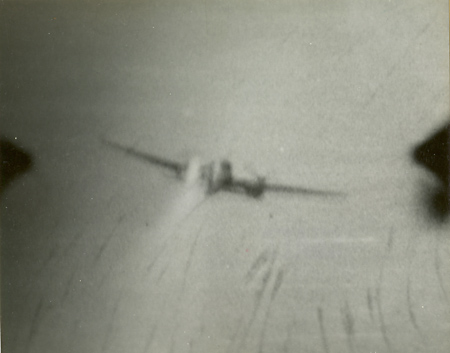
|
|
Gun camera shot of Junkers JU-88 catching fire during attack by Ranger CAP F4Fs. The plane was shot down with no survivors.
|
|
|
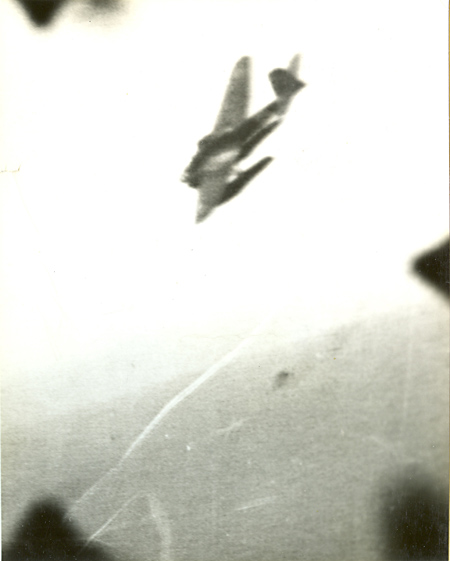
|
|
Gun camera shot of Heinkel HE-115 floatplane under attack by Ranger CAP F4Fs. The plane was shot down. Three survivors were observed in the water but no rescue could be attempted.
|
|
|
|
|
1603
|
Anti-aircraft alarm for greater Sandnessjöen and Brohnoysund. (This was a false alarm.)
|
|
1741
|
Ranger flight operations secured. Returning to Scapa Flow with the British Home Fleet. (Cressman)
|
|
1845
|
The German Report states: From Squadron Leader Lofoten 1300 06 East. 17 war ships and a carrier sighted. Course 90 degrees.
|
|
|
Task Force 121 returned to Scapa Flow on October 8, 1943.
|
|
|
|
|
|
Ships Under Attack Cited in the German Report
- Steamship Rabat hit by bomb and sunk.
- Steamship Cap Quir damaged by bomb under the waterline.
- Steamship Malaga lightly damaged by a dud bomb. This ship is incorrectly identified as Saar.
- Steamship Ibis lightly damaged.
- Freight barge MFS 231, with 40 tons of ammunition, hit by bomb and beached.
- Troop Transport Skramstad hit by bomb. Burning and beached. Cressman reports that of the 834 soldiers aboard, 200 were killed and 15 were seriously wounded. One Norwegian crewman was killed..
- Steamship Wolsum damaged by on board weapons shelling.
- Steamship La Plata hit by 3 bombs. Burning and beached. This ship was hit by both Strike Groups.
- Tanker Schleswig hit by 3 bombs, becomes unable to be maneuvered. In US reports, this ship is identified as a Rigmor-class tanker.
- Steamship Kerkplein hit by 2 bombs, rear part of ship burns, rudder fall out. In US reports, this ship is identified as a 5,000 gross ton merchant vessel. Cressman reports that this ship had 1,551 Russian prisoners on board. The bombing killed 14 of the prisoners, seriously wounded 29, and left 9 missing.
- Navy 365. In US reports, this ship is identified as an ex-Norwegian Sleipner-class destroyer. US reports state that it was heavily strafed.
- Steamship Vaagen sunk after being hit by bomb.
- Steamship Topeka burning after being hit by 3 bombs and grounded.
|
|
|
|
American Airmen Lost and Planes Damaged
At the conclusion of OPERATION LEADER, the Ranger log shows the following 7 persons from Air Group 4 "missing in action."
- Lt(jg) John H. Palmer with crewmen Joseph L. Zalom, ART1c and Reginald H. Miller, AMM1c (TBF 4-T-4).
- Lt(jg) Clyde A. Tucker, Jr. with his turret gunner Stephen D. Bakran, ARM2c (SBD 4-B-19).
- Lt(jg) Sumner R. Davis with his turret gunner D. W. McCarley, ARM2c (SBD 4-B-15).
Palmer, Davis, and McCarley survived and were POWs of the Germans. The other four, Zalom, Miller, Tucker, and Bakran were killed when their planes were shot down. (See Airmen Missing in Action and Prisoners of War from Air Group 4 for an account of the POW experiences of Palmer and Davis.)
Other Planes Damaged
- Lt(jg) George M. Harris, Jr was wounded by anti-aircraft fire, made a hard landing on the carrier, collapsing his landing gear, and was taken to sick bay (F4F 4-F-1).
- TBF 4-T-9 (Lt(jg) Gerald W. Thomas) hit in the engine, crash-landed on a wave-off as engine froze from lack of oil.
- SBD 4-B-11 (Lt Cecil V. Johnson) one hit on starboard wing. No adverse effects on controls.
- SBD 4-B-23 (Lt Richard W. Phillips) was hit, apparently by explosive 40 mm on right stabilizer resulting in holes in fin and rudder, one hit on left wing, apparently same type of shell, fragments nicked the gasoline tank but did not puncture it, fragments also pierced upper skin of wing. No adverse effects on controls.
- SBD 4-B-13 (Lt Lykes M. Boykin) received three hits on the starboard wing by what appeared to be 20 mm; several hits on port elevator and horizontal stabilizer and one hit on starboard horizontal stabilizer. Controls not effected.
- SBD 4-B-27 (Lt George C. Simmons) hit by 40 mm in radio compartment aft of rear gunner, right rudder cable severed, battery, IFF and radar damaged during attack on Schleswig.
Analysis by American and British Commanders
"During the actual operation, the approach strategy was excellent. I believe we caught the enemy absolutely by surprise. The design of the run through the leads was also good, but had it been known that aircraft opposition was not going to be encountered, I am sure we would have taken more time to cruise up and down the leads and pick our targets. As it was, and going on the opinions rendered by British and Norwegian liaison personnel and the previous experiences of coastal raiders, we took the first likely targets without waiting to pick and choose between them and far `juicier´ units which were seen further up the leads attacked with about half our strength. To this end, a strike at Bodo airport first would have assured us that no aircraft were to be encountered and more time could have been taken in the leads."
"The Avenger is definitely the plane for this type of work. It must be supported, however, by Wildcats (1 or 2 Wildcats for each Avenger). The best form of attack is a 30 degree jinking glide with slight pull out and release at masthead height, just short of the target. This involves good speed (240 knots) and doesn't expose the bomber to concentrated AA fire for long. The fighter, or fighters, should be with the bomber and strafe the target all the way in."
"LEADER was definitely an excellent training exercise for CAG-4. We went in as many boys and came out as many men." - Cdr. Joseph A. Ruddy, Commander Carrier Air Group 4.
"This was the first action for many of the pilots employed (60%). As a result, there was an undue eagerness to over expend ammunition against the first targets that showed up. Undoubtedly, in future operations, pilots will be more cautious in the expenditure of their ammunition. Several fine targets were passed up because all bombs had been expended. However, the loss of three pilots due to anti-aircraft fire and the mute testimony of bullet-ridden planes upon return to the ship indicate that the pilots drove home their attacks in accordance with the best traditions of the service and all credit is due to the flight personnel for their splendid work in inflicting so much damage on the enemy."
"It is recommended that the Navy Department give serious consideration as to the future of the Ranger. With the exception of the TBFs, her planes are obsolete, the SBD particularly so…. We should not ask our pilots to fight in obsolete aircraft when better types are available and provision can be made for their use." - Capt. Gordon Rowe, Commander of the USS Ranger.
"OPERATION LEADER was executed as planned. Except for an 18-minute delay in launching, which was the result of a near calm prevailing at the zero hour, the planned schedule was closely adhered to by both striking groups. The flight deck and hangar deck crews of the Ranger functioned smoothly and efficiently."
"The amount of shipping encountered was far beyond the average expected to be encountered at any one time within the stretch of the leads which was swept by the striking groups…."
"Excluding the four bombs of the Avenger which was shot down before having an opportunity to attack, the percentage of bomb hits, based on observations and estimates of the flight crews, was 21%…."
"Five bombs remained on the racks of torpedo planes when they returned on board. Pilots of these planes were under the impression that they had released all bombs…."
"The two duds reported may have been the result of insufficient air travel to arm the bomb fuses…."
"Stoppages occurred on approximately 12% of the fixed guns of the fighters, a figure which should be reduced through improved gun maintenance and inspection of ammunition."
"Fighter direction was good, and the fighter pilots disposed of the two shadowers with dispatch after making contact. In the case of the two shadowers which got away, the German pilots apparently approached the formation for one quick look and then retired at high speed…."
"The inadequacy of the designed speed of the Ranger was keenly felt in this operation. It was necessary to reduce the loading of 6 of the Dauntlesses from 1,000 to 500 pound bombs, based on the weather forecast for the morning of the launching, and 18 minutes were lost in searching for enough wind to enable the planes to be launched…."
"As stated in the beginning, the damage inflicted on the enemy in this operation was considerable, and the outcome regarded by British Naval authorities as being highly successful…. In this operation with the British Home Fleet in which they played the leading roles, the Ranger and her Air Group have brought much credit to themselves and to the United States Navy." - Rear Admiral O. M. Hustvedt, Commander if Task Force 121 (Operating with the British Home Fleet).
"From the results of the operation as observed and photographed, it appears that a damaging blow was struck at enemy shipping… LEADER was executed essentially as planned." - Admiral Sir Bruce Fraser, Commander of the British Home Fleet.
As the USS Ranger entered Scapa Flow on October 8, 1943, Admiral Fraser asked for a special cheer from ships in the Flow and issued a "Well Done" to Norway Raiders. The Admiral added, "The attack represents an important blow by the United States Navy Task Force now attached to the Home Fleet."
Additional References on OPERATION LEADER
Two very good articles on OPERATION LEADER have been published by Norwegians:
(l) "OPERATION LEADER: Amerikansk Flyangrep i NORGE UNDER KRIGER" by Steinbjorn Mentzoni.
(2) "Da AMERIKANERE SLOSS i NORGE 1943" based on research by Knut Store, Norwegian Air Force.
(3) The January 1992 issue of World War II magazine carried an article entitled "Attack Driven Home". This article is a personal account of OPERATION LEADER by Gerald W. Thomas, Torpedo Four Pilot.
(4) An excellent comprehensive history of the USS Ranger was published in the Spring and Summer issues of The Hook: Journal of Carrier Aviation by Robert Cressman. These articles include summaries of OPERATION TORCH (North Africa) and OPERATION LEADER (Norway). The articles are entitled "A Very Valuable Ship: An Operational History of USS Ranger (CV-4) 1934-1946."
(5) In 2003, Robert Cressman´s book USS Ranger: The Navy´s First Flattop from Keel to Mast was published by Brassey´s Inc. This excellent book gives a detailed account of OPERATION TORCH, drawn from US sources. The account here corrects a few mistakes in the book´s reconstruction of the operation.
(6) The Winter 1993 issue of The Hook contains an article on Dean S. "Diz" Laird, VF-4 by Barrett Tillman. Diz relates his experiences with Air Group 4 on the USS Ranger and in the Pacific. He was one of five AG-4 airman to participate in the 50th anniversary recognition ceremony held in Norway on October 4, 1993.
(7) In 1993, Thomas Gates completed his history of Fighting Squadron Fourteen: Tophatters (VB-4 was called "Tophatters" on the USS Ranger, USS Bunker Hill, and USS Essex during WWII). The book was released by Squadron/Signal Publications, Carrollton, Texas.
(8) Two follow-up reports on OPERATION LEADER are this web site:
"Norway: A Grateful Nation Remembers" by Gerald W. Thomas, 1993.
"USS Ranger Veterans Return To Norway" by Gerald W. Thomas, 2001.
(9) Here are two accounts by survivors of the attack on the Skramstad:
"We Survived" by Bernhard A. E. Nolte.
"An Amateur Astronomer in the German Army" by Franz Graetsch.
(10) Here is the NY Times account of OPERATION LEADER:
Operation Leader - October 4, 1943
(11) A report on the MIAs and POWs of Air Group 4 is given here:
Airmen Missing in Action and Prisoners of War from Air Group 4
|
|
|
|
 |
|
|

